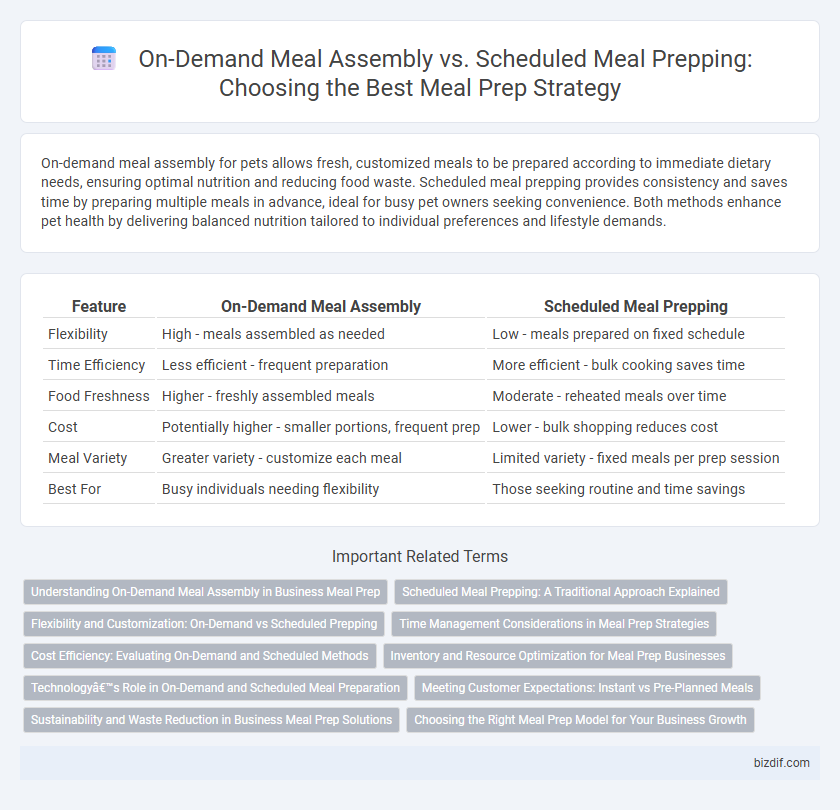On-demand meal assembly for pets allows fresh, customized meals to be prepared according to immediate dietary needs, ensuring optimal nutrition and reducing food waste. Scheduled meal prepping provides consistency and saves time by preparing multiple meals in advance, ideal for busy pet owners seeking convenience. Both methods enhance pet health by delivering balanced nutrition tailored to individual preferences and lifestyle demands.
Table of Comparison
| Feature | On-Demand Meal Assembly | Scheduled Meal Prepping |
|---|---|---|
| Flexibility | High - meals assembled as needed | Low - meals prepared on fixed schedule |
| Time Efficiency | Less efficient - frequent preparation | More efficient - bulk cooking saves time |
| Food Freshness | Higher - freshly assembled meals | Moderate - reheated meals over time |
| Cost | Potentially higher - smaller portions, frequent prep | Lower - bulk shopping reduces cost |
| Meal Variety | Greater variety - customize each meal | Limited variety - fixed meals per prep session |
| Best For | Busy individuals needing flexibility | Those seeking routine and time savings |
Understanding On-Demand Meal Assembly in Business Meal Prep
On-demand meal assembly in business meal prep allows companies to customize meals tailored to employee preferences and dietary needs, enhancing satisfaction and reducing food waste. This flexible approach contrasts with scheduled meal prepping by offering real-time adjustments based on immediate demand, streamlining inventory management and operational efficiency. Businesses leveraging on-demand assembly benefit from improved meal variety, fresher ingredients, and optimized resource allocation.
Scheduled Meal Prepping: A Traditional Approach Explained
Scheduled meal prepping involves planning and preparing meals in advance according to a fixed routine, often weekly or bi-weekly, ensuring consistent nutrition and portion control. This traditional approach reduces daily cooking time, minimizes food waste, and supports dietary goals by allowing precise ingredient selection and meal customization. Popular in households balancing busy schedules, scheduled meal prepping promotes healthier eating habits through organized meal planning and efficient kitchen management.
Flexibility and Customization: On-Demand vs Scheduled Prepping
On-demand meal assembly offers unparalleled flexibility by allowing consumers to select meals based on daily preferences and nutritional needs, accommodating spontaneous schedule changes and dietary adjustments. Scheduled meal prepping provides consistency and time efficiency, delivering predefined meals at regular intervals, which supports structured dietary plans but limits customization. Both approaches enhance convenience but differ in adaptability, with on-demand excelling in personalized, anytime meal choices and scheduled prepping optimizing routine and bulk preparation.
Time Management Considerations in Meal Prep Strategies
On-demand meal assembly offers flexibility by allowing meal preparation only when needed, minimizing food waste and adapting to changing schedules. Scheduled meal prepping requires dedicated blocks of time, typically once or twice a week, promoting consistency and efficient portion control. Efficient time management in meal preparation balances spontaneity and routine, optimizing nutritional goals and lifestyle demands.
Cost Efficiency: Evaluating On-Demand and Scheduled Methods
On-demand meal assembly often incurs higher costs due to frequent ingredient purchases and limited bulk-buying opportunities, while scheduled meal prepping leverages bulk buying and batch cooking to reduce per-meal expenses. Scheduled prepping minimizes food waste by using ingredients efficiently across multiple meals, enhancing overall cost efficiency. Choosing scheduled meal prepping can significantly lower grocery bills and optimize resource use compared to on-demand assembly.
Inventory and Resource Optimization for Meal Prep Businesses
On-demand meal assembly allows meal prep businesses to optimize inventory by reducing excess stock and minimizing food waste through precise ingredient usage based on real-time orders. Scheduled meal prepping enables bulk purchasing and batch cooking, improving resource allocation by streamlining labor and kitchen operations but may increase the risk of ingredient spoilage if demand forecasts are inaccurate. Balancing on-demand assembly with scheduled prepping can maximize inventory turnover rates and enhance overall operational efficiency.
Technology’s Role in On-Demand and Scheduled Meal Preparation
Technology enhances on-demand meal assembly by enabling real-time customization through apps and AI-driven recommendations, streamlining ingredient sourcing and minimizing waste. Scheduled meal prepping benefits from automation in batch cooking devices and inventory management systems, ensuring precise portion control and nutritional balance. Integration of IoT kitchen appliances facilitates seamless transitions between on-demand and scheduled preparation, optimizing efficiency and user convenience.
Meeting Customer Expectations: Instant vs Pre-Planned Meals
On-demand meal assembly offers customers immediate access to fresh, customized meals, aligning with the growing demand for convenience and spontaneity. Scheduled meal prepping caters to those who prefer structured planning, ensuring portion control and nutritional consistency over time. Meeting customer expectations requires balancing the need for instant meal solutions with the benefits of pre-planned, health-conscious dining options.
Sustainability and Waste Reduction in Business Meal Prep Solutions
On-demand meal assembly enables businesses to prepare meals only when needed, significantly minimizing food waste and enhancing sustainability by reducing excess inventory and spoilage. Scheduled meal prepping, while efficient for bulk production, often results in surplus meals that may go unused, contributing to food waste and higher environmental impact. Prioritizing on-demand systems leverages real-time demand data, optimizing ingredient usage and promoting eco-friendly practices in commercial meal prep operations.
Choosing the Right Meal Prep Model for Your Business Growth
On-demand meal assembly offers flexibility and customization, allowing businesses to cater to immediate customer preferences and reduce food waste. Scheduled meal prepping emphasizes efficiency and consistency, enabling bulk purchasing and streamlined production that lowers operational costs. Selecting the right meal prep model depends on target market demands, operational capacity, and growth objectives to maximize profitability and customer satisfaction.
On-demand meal assembly vs scheduled meal prepping Infographic

 bizdif.com
bizdif.com